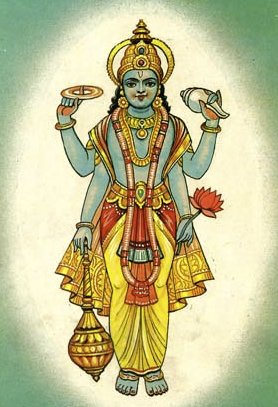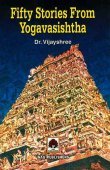Nirguna, Nirguṇa, Nirguṇā, Nir-guna, Nirgunate: 20 definitions
Introduction:
Nirguna means something in Hinduism, Sanskrit, Marathi, Hindi. If you want to know the exact meaning, history, etymology or English translation of this term then check out the descriptions on this page. Add your comment or reference to a book if you want to contribute to this summary article.
Alternative spellings of this word include Nirgun.
In Hinduism
Vaishnavism (Vaishava dharma)
Source: humindian: 108 names of Lord KrishnaOne of the 108 names of Krishna; Meaning: "Without Any Properties"
Source: Pure Bhakti: Bhagavad-gita (4th edition)Nirguṇa (निर्गुण) refers to “devoid of material qualities; transcendental to the modes of nature”. (cf. Glossary page from Śrīmad-Bhagavad-Gītā).
Source: Pure Bhakti: Brhad BhagavatamrtamNirguṇa (निर्गुण) refers to:—Devoid (nir) of material qualities (guṇa), transcendental; free from the influence of the material qualities of goodness, passion, and ignorance. In relation to Śrī Kṛṣṇa, this implies that He is endowed with transcendental qualities. (cf. Glossary page from Śrī Bṛhad-bhāgavatāmṛta).

Vaishnava (वैष्णव, vaiṣṇava) or vaishnavism (vaiṣṇavism) represents a tradition of Hinduism worshipping Vishnu as the supreme Lord. Similar to the Shaktism and Shaivism traditions, Vaishnavism also developed as an individual movement, famous for its exposition of the dashavatara (‘ten avatars of Vishnu’).
Purana and Itihasa (epic history)
Source: archive.org: Shiva Purana - English Translation1 Nirguṇa (निर्गुण) or “attributeless” is used to describe Śiva, according to the Śivapurāṇa 2.2.41. Accordingly. [as Viṣṇu and others eulogized Śiva]—“[...] obeisance to Śiva who is calm, the supreme and the highest soul, of matted hair, great lord and the bright one. You are the creator of the creators of the universe. You are the sustainer and the forefather, possessed of three attributes (triguṇātma) and attributeless (nirguṇa). You are greater than primordial nature and the supreme Being”.
2) Nirguṇā (निर्गुणा) refers to “she who is devoid of the three qualities” and is used to describe the Goddess (e.g., Umā/Durgā/Satī), according to the Śivapurāṇa 2.3.4.—Accordingly, as the Gods eulogized Umā with devotion:—“[...] thus eulogised by the Gods, the Goddess Durgā, the mother of the universe, the destroyer of impassable distress, appeared in front of them. [...] She was the unequalled supreme illusion, the beautiful wife of Sadāśiva. She had all the three qualities and was devoid of attributes (i.e., Nirguṇā) also, she had been staying in the region of Śiva”.
Note: As the personified energy of the gods Viṣṇu, Brahmā and Rudra, representing the three qualities Sattva, Rajas and Tamas, the Goddess is called ‘Triguṇā’ i.e. possessed of three qualities. But as the personified energy of Śiva, who is the Supreme Being, devoid of attributes she is called Nirguṇā.
Source: Cologne Digital Sanskrit Dictionaries: The Purana IndexNirguṇā (निर्गुणा).—A third mātra of o.*
- * Vāyu-purāṇa 20. 2.

The Purana (पुराण, purāṇas) refers to Sanskrit literature preserving ancient India’s vast cultural history, including historical legends, religious ceremonies, various arts and sciences. The eighteen mahapuranas total over 400,000 shlokas (metrical couplets) and date to at least several centuries BCE.
Shaktism (Shakta philosophy)
Source: Google Books: ManthanabhairavatantramNirguṇā (निर्गुणा) refers to “she who is devoid of qualities”, according to the Lalitāsahasranāma.—Lalitā’s thousand names are eulogized in the Lalitāsahasranāma, describing the goddess’s spiritual beauty on the analogy of physical, sensuous beauty. [...] In short, the Kula rites—sexual yet chaste—share in the same ambiguity as the goddess who presides over them. One way that the apparent contradiction is resolved is to accommodate the two conditions into the two aspects of deity. Tripurā in her immanent, manifest form ‘with qualities’ (saguṇa) is passionate, while her unmanifest form `devoid of qualities’ (nirguṇa) is passionless. To indicate this ambiguity in her nature she is called ‘Devoid of Qualities’ (nirguṇā) (130), which is thus the same as calling her ‘Devoid of Desire’ (niṣkāmā) (142) and ‘Devoid of Passion’ (nīrāgā) (156). So even though from one point of view she is highly passionate, she remains free of desire. Although, she gives passion (kāmadā) and arouses attachment (rāga-mathanī) (157), she also frees from it.

Shakta (शाक्त, śākta) or Shaktism (śāktism) represents a tradition of Hinduism where the Goddess (Devi) is revered and worshipped. Shakta literature includes a range of scriptures, including various Agamas and Tantras, although its roots may be traced back to the Vedas.
Shaivism (Shaiva philosophy)
Source: Brill: Śaivism and the Tantric Traditions1) Nirguṇa (निर्गुण) refers to “one who lacks qualities”, according to the 13th-century Matsyendrasaṃhitā: a Kubjikā-Tripurā oriented Tantric Yoga text of the Ṣaḍanvayaśāmbhava tradition from South India.—Accordingly, “That noble lady abandons her family and goes to the highest man, who is invisible, who lacks qualities (nirguṇa), and is devoid of kula and form”.
2) Nirguṇa (निर्गुण) refers to “one who is lacking qualities”, according to Jayaratha ad Nityāṣoḍaśikārṇava verse 4.14.—Accordingly, “Then leaving behind the kula, i.e. the body, she goes to the one who is in the realm of akula, the supreme, i.e. full […] Person, the highest authority, who is without a body and without bodily form, with his innate nature manifest and therefore lacking qualities (nirguṇa), i.e. she reaches oneness with Him. This is the meaning [of this verse]”.

Shaiva (शैव, śaiva) or Shaivism (śaivism) represents a tradition of Hinduism worshiping Shiva as the supreme being. Closely related to Shaktism, Shaiva literature includes a range of scriptures, including Tantras, while the root of this tradition may be traced back to the ancient Vedas.
Languages of India and abroad
Marathi-English dictionary
Source: DDSA: The Molesworth Marathi and English Dictionarynirguṇa (निर्गुण).—a (S) pop. nirguṇī a That is without attributes or properties;--used of the Deity. 2 That is without good qualities or properties.
Source: DDSA: The Aryabhusan school dictionary, Marathi-Englishnirguṇa (निर्गुण).—a nirguṇī a That is without attri- butes. That is without good qualities.
Marathi is an Indo-European language having over 70 million native speakers people in (predominantly) Maharashtra India. Marathi, like many other Indo-Aryan languages, evolved from early forms of Prakrit, which itself is a subset of Sanskrit, one of the most ancient languages of the world.
Sanskrit dictionary
Source: DDSA: The practical Sanskrit-English dictionaryNirguṇa (निर्गुण).—a.
1) stringless (as a bow).
2) devoid of all properties.
3) devoid of good qualities, bad, worthless; निर्गुणः शोभते नैव विपुलाड- म्बरोऽपि ना (nirguṇaḥ śobhate naiva vipulāḍa- mbaro'pi nā) Bv.1.115.
4) without attributes; साकारं च निराकारं सगुणं निर्गुणं विभुम् (sākāraṃ ca nirākāraṃ saguṇaṃ nirguṇaṃ vibhum) Brahmavai. P.
5) having no epithet.
-ṇaḥ the Supreme Spirit. °आत्मक (ātmaka) a. having no qualities.
Nirguṇa is a Sanskrit compound consisting of the terms nir and guṇa (गुण).
Source: Cologne Digital Sanskrit Dictionaries: Shabda-Sagara Sanskrit-English DictionaryNirguṇa (निर्गुण).—mfn.
(-ṇaḥ-ṇā-ṇaṃ) 1. Void, of all properties. 2. Bad, worthless, having no good qualities. 3. Stringless. m.
(-ṇaḥ) The Supreme Being, or any deity so considered. E. nir privative, and guṇa a property, an excellence.
Source: Cologne Digital Sanskrit Dictionaries: Benfey Sanskrit-English DictionaryNirguṇa (निर्गुण).—adj., f. ṇā, 1. without a string, [Mṛcchakaṭikā, (ed. Stenzler.)] 131 17. 2. without qualities, Mahābhārata 1, 2432. 3. devoid of virtue, [Rāmāyaṇa] 2, 33, 11.
Nirguṇa is a Sanskrit compound consisting of the terms nis and guṇa (गुण).
Source: Cologne Digital Sanskrit Dictionaries: Cappeller Sanskrit-English DictionaryNirguṇa (निर्गुण).—[adjective] having no thread or string; devoid of attributes, qualities, or virtues, [abstract] tā [feminine], tva [neuter]
Source: Cologne Digital Sanskrit Dictionaries: Monier-Williams Sanskrit-English Dictionary1) Nirguṇa (निर्गुण):—[=nir-guṇa] [from nir > niḥ] a mf(ā)n. having no cord or string, [Kāvya literature]
2) [v.s. ...] having no good qualities or virtues, bad, worthless, vicious, [Mahābhārata; Rāmāyaṇa] etc.
3) [v.s. ...] devoid of all qualities or properties, [Upaniṣad; Mahābhārata] etc.
4) [v.s. ...] having no epithet, [Kātyāyana-śrauta-sūtra] [Scholiast or Commentator]
5) [v.s. ...] (said of the Supreme Being), [Horace H. Wilson]
6) [=nir-guṇa] b etc. See p. 541, col. 1.
Source: Cologne Digital Sanskrit Dictionaries: Yates Sanskrit-English DictionaryNirguṇa (निर्गुण):—[nir-guṇa] (ṇaḥ-ṇā-ṇaṃ) a. Void of all properties; bad. m. God.
Source: DDSA: Paia-sadda-mahannavo; a comprehensive Prakrit Hindi dictionary (S)Nirguṇa (निर्गुण) in the Sanskrit language is related to the Prakrit word: Ṇigguṇa.
[Sanskrit to German]
Sanskrit, also spelled संस्कृतम् (saṃskṛtam), is an ancient language of India commonly seen as the grandmother of the Indo-European language family (even English!). Closely allied with Prakrit and Pali, Sanskrit is more exhaustive in both grammar and terms and has the most extensive collection of literature in the world, greatly surpassing its sister-languages Greek and Latin.
Hindi dictionary
Source: DDSA: A practical Hindi-English dictionaryNirguṇa (निर्गुण) [Also spelled nirgun]:—(a) without attributes or qualities, without [sata, raja] and [tama guṇa]s; an epithet of God who is beyond the three [guṇa]s (see); —[brahma] the Supreme Soul unlimited by the three [guṇa]s.
...
Kannada-English dictionary
Source: Alar: Kannada-English corpusNirguṇa (ನಿರ್ಗುಣ):—
1) [adjective] not stringed; not having a string or cord.
2) [adjective] not having attributes.
--- OR ---
Nirguṇa (ನಿರ್ಗುಣ):—
1) [noun] that (as a bow) which is not stringed.
2) [noun] a formless thing.
3) [noun] a ruthless, punctilious man.
4) [noun] the Supreme Being.
5) [noun] a being completely absorbed in abstract meditation.
--- OR ---
Nirguṇate (ನಿರ್ಗುಣತೆ):—
1) [noun] the quality of being attributeless; absoluteness.
2) [noun] the state of a thing (as of the Supreme Being) that cannot be attributed with any qualities, characteristics, etc.
3) [noun] absence of good or desirable qualities.
4) [noun] the condition of being not stringed, tied with a cord, rope, etc.
Kannada is a Dravidian language (as opposed to the Indo-European language family) mainly spoken in the southwestern region of India.
See also (Relevant definitions)
Partial matches: Nir, Guna, Nish.
Starts with: Nirguna-brahman, Nirgunabhakti, Nirgunabrahma, Nirgunabrahmavadi, Nirgunabrahmavidye, Nirgunaka, Nirgunamamasa, Nirgunapa, Nirgunaradhane, Nirgunasakshatkara, Nirgunashraddha, Nirgunasvarupa, Nirgunata, Nirgunatattva, Nirgunatmaka, Nirgunatva, Nirgunavayu.
Full-text (+52): Nirgunatva, Nirgunata, Nairgunya, Nigguna, Nirguna Brahman, Nirgunatattva, Nirgunaka, Nirgunamamasa, Vidharma, Nurguniya, Nirkkuni, Nirgunatmaka, Niraguna, Saguna Brahman, Niraguniya, Agan, Nijabodha, Nirdosha, Agana, Niguna.
Relevant text
Search found 82 books and stories containing Nirguna, Nirguṇa, Nirguṇā, Nir-guna, Nir-guṇa, Nis-guna, Nis-guṇa, Nirgunate, Nirguṇate; (plurals include: Nirgunas, Nirguṇas, Nirguṇās, gunas, guṇas, Nirgunates, Nirguṇates). You can also click to the full overview containing English textual excerpts. Below are direct links for the most relevant articles:
Brihad Bhagavatamrita (commentary) (by Śrī Śrīmad Bhaktivedānta Nārāyana Gosvāmī Mahārāja)
Verse 2.2.177 < [Chapter 2 - Jñāna (knowledge)]
Verse 2.3.134 < [Chapter 3 - Bhajana (loving service)]
Verse 2.2.179 < [Chapter 2 - Jñāna (knowledge)]
Shrimad Bhagavad-gita (by Narayana Gosvami)
Verse 2.45 < [Chapter 2 - Sāṅkhya-yoga (Yoga through distinguishing the Soul from the Body)]
Verse 13.15 < [Chapter 13 - Prakṛti-puruṣa-vibhāga-yoga]
Verse 2.41 < [Chapter 2 - Sāṅkhya-yoga (Yoga through distinguishing the Soul from the Body)]
Garga Samhita (English) (by Danavir Goswami)
Verse 6.2.31 < [Chapter 2 - Residence in Śrī Dvārakā]
Verse 2.15.31 < [Chapter 15 - Description of Śrī Rādhā-Kṛṣṇa’s Falling in Love]
Verse 5.4.23 < [Chapter 4 - The Journey to Śrī Mathurā]
Tattvartha Sutra (with commentary) (by Vijay K. Jain)
Verse 5.41 - Definition of guṇa (qualities) < [Chapter 5 - The Non-living Substances]
Hari-bhakti-kalpa-latikā (by Sarasvati Thkura)
Text 13 < [Second Stabaka]
Related products
